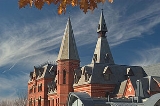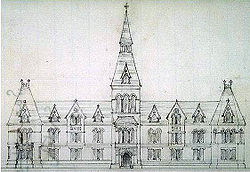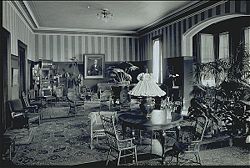

Ithaca
, New York
campus. It was originally designed to be a residential building, however, currently it houses the Johnson Graduate School of Management. Its design was based upon that of the Dinosaur Hall at Oxford University's Museum of Natural History
.
Conception

, to advance a revolutionary concept at the time. "When you are ready to carry out the idea of educating young women as thoroughly as young men," Sage told his friend, Ezra Cornell
in 1868, "I will provide the endowment to enable you to do so." Although women had previously enrolled in Cornell as early as 1870, the absence of a women's domitory was problematic in attracting and retaining female students. Sage and Andrew Dickson White toured Oberlin College to study the facilities necessary for successful coeducation.
With Sage's $250,000 donation, construction started four years later under the guidance of professor of architecture Charles Babcock
. In 1875, Sage College welcomed 25 female students, making the university a pioneer in coeducation and attracting a swarm of applications. Early graduates included two college presidents, Julia Josephine Thomas Irvine (Wellesley) and Martha Carey Thomas (Bryn Mawr); a prominent women's suffragist, Harriet May Mills; a publisher and author, Ruth Putnam; and the noted Cornell professor and scientist, Anna Botsford Comstock
.
Facilities
When the building opened, it offered some of the most luxurious accommodations of any college dormitory in the United States. Residents had access to a swimming pool, gym, botanical conservatory, indoor plumbing, and luscious furnishings. Additionally, the building contained features that defined it as a residential college
as opposed to a traditional dormitory
such as a dining hall, classrooms, a library, and professorial offices. It had the ability to house up to 120 students.

Later years
Between April 1996 and August 1998, the university untertook a massive renovation of Sage Hall, at the cost of $38 million, to convert the building into the new home for the Johnson Graduate School of Management. The top segment of the building's iconic spire that had been removed years before was rebuilt. A glass ceiling was constructed over the inner courtyard changing it into an atrium. The design of that space was influenced by "Dinosaur Hall" at the Oxford University Museum of Natural History. Interestingly, Babcock's original design of Sage Hall had been influenced by that same museum's design.
Cornerstone letter regarding nonsectarianism
Ezra Cornellwas a birthright Quaker
, but was later disowned by the Society of Friends for marrying outside of the faith to a "world's woman," a Methodist
by the name of Mary Ann Wood. Ezra and Mary Ann were married March 19, 1831, in Dryden, New York
.
On February 24, 1832, a disheartened Ezra Cornell wrote the following response to his expulsion from The Society of Friends due to his marriage to Mary Ann Wood:
"I have always considered that choosing a companion for life was a very important affair and that my happiness or misery in this life depended on the choice…"
There is a reason why this nation was founded on the principle of separation of Church and State. Religion and politics are immiscible as oil and water.
Ezra Cornell felt the same way about his university. What Professors Isaac Kramnick and Laurence Moore have shown to be a "Godless Constitution" is mirrored in the phrase religious conservatives used to describe this university in its early years: they called it "Godless Cornell."
In 1873, the cornerstone of Sage Hall was laid. This new hall was to house the Sage College for Women and thus to concretely establish Cornell University's coeducational status. Ezra Cornell wrote a letter for posterity—dated 15 May, 1873—and sealed it into the cornerstone. No copies of the letter were made, and Cornell kept its contents a secret. However, he hinted at the theme of the letter during his speech at the dedication of Sage Hall, stating that "the letter deposited in the cornerstone addressed to the future man and woman, of which I have kept no copy, will relate to future generations the cause of the failure of this experiment, if it ever does fail, as I trust in God it never will."
Cornell historians largely assumed that the "experiment" to which Cornell referred was that of coeducation, given that Sage Hall was to be a women's dormitory and that coeducation was still a controversial issue at the time. However, when the letter was finally unearthed in 1997, its focus was revealed to be the university's nonsectarian status—a principle that had invited controversy in the 19th century, given that most universities of the time had religious affiliations. Cornell wrote:
On the occasion of laying the corner stone of the Sage College for women of Cornell University, I desire to say that the principle danger, and I say almost the only danger I see in the future to be encountered by the friends of education, and by all lovers of true liberty is that which may arise from sectarian strife.
From these halls, sectarianism must be forever excluded, all students must be left free to worship God, as their concience shall dictate, and all persons of any creed or all creeds must find free and easy access, and a hearty and equal welcome, to the educational facilities possessed by the Cornell University.
Coeducation of the sexes and entire freedom from sectarian or political preferences is the only proper and safe way for providing an education that shall meet the wants of the future and carry out the founders idea of an Institution where "any person can find instruction in any study." I herewith commit this great trust to your care.
Notable alumnae
- Anna Botsford ComstockAnna Botsford ComstockAnna Botsford Comstock , was a US artist, educator, conservationist, and a leader of the nature study movement, born in Otto, New York, to Marvin and Phebe Irish Botsford....
- professorProfessorA professor is a scholarly teacher; the precise meaning of the term varies by country. Literally, professor derives from Latin as a "person who professes" being usually an expert in arts or sciences; a teacher of high rank...
and scientistScientistA scientist in a broad sense is one engaging in a systematic activity to acquire knowledge. In a more restricted sense, a scientist is an individual who uses the scientific method. The person may be an expert in one or more areas of science. This article focuses on the more restricted use of the word...
, namesake of Cornell's Comstock Hall - Julia Josephine Thomas Irvine - fourth president of Wellesley College
- Harriet May Mills - women's suffragist
- Ruth Putnam - publisher and authorAuthorAn author is broadly defined as "the person who originates or gives existence to anything" and that authorship determines responsibility for what is created. Narrowly defined, an author is the originator of any written work.-Legal significance:...
- M. Carey ThomasM. Carey ThomasMartha Carey Thomas was an American educator, suffragist, and second President of Bryn Mawr College.-Early life:...
- first president of Bryn Mawr CollegeBryn Mawr CollegeBryn Mawr College is a women's liberal arts college located in Bryn Mawr, a community in Lower Merion Township, Pennsylvania, ten miles west of Philadelphia. The name "Bryn Mawr" means "big hill" in Welsh....

